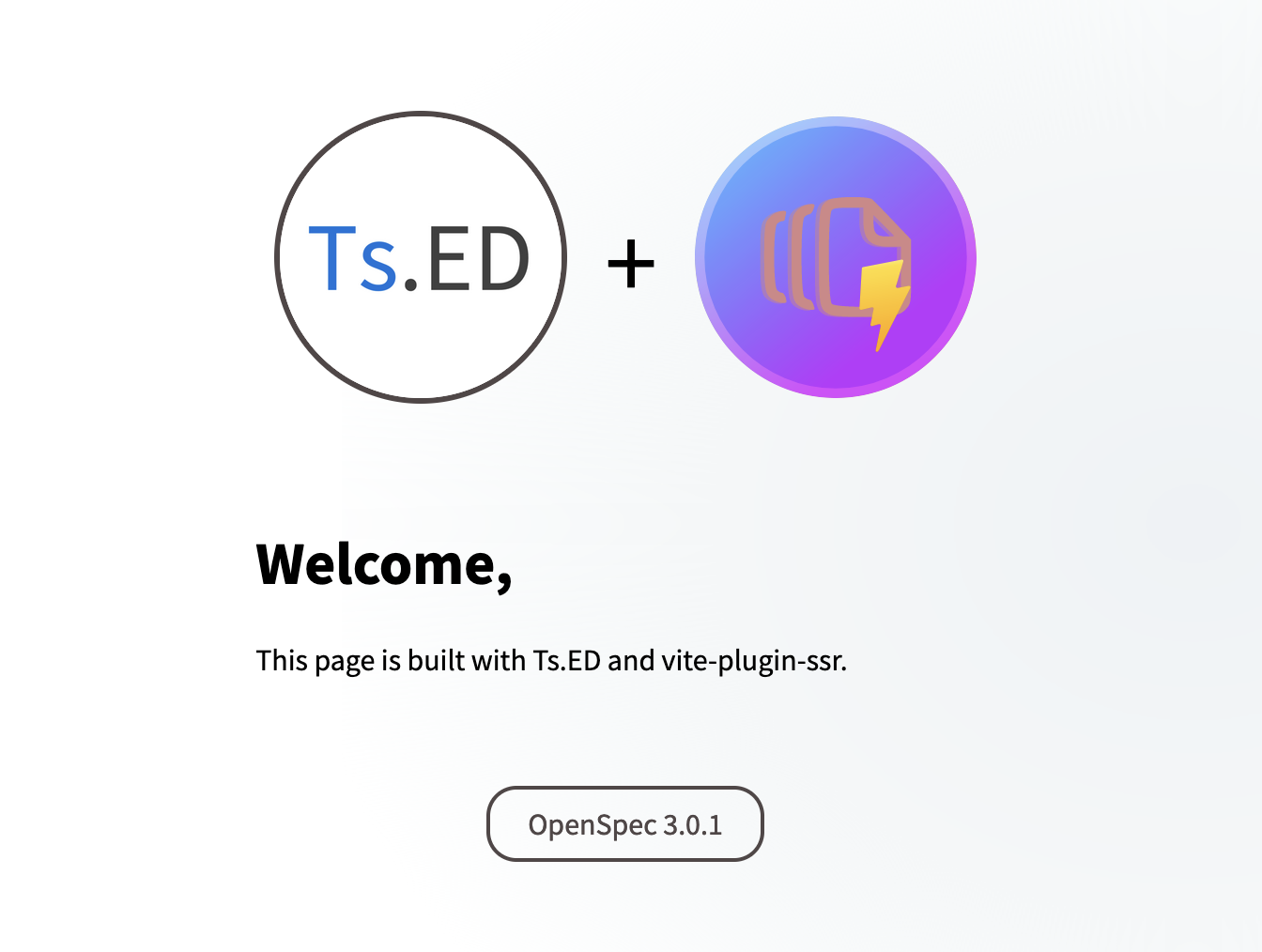# Vike
Like Next.js/Nuxt but as a do-one-thing-do-it-well Vite plugin.
Use any UI framework (React, Vue, Svelte, Solid, ...) and any tool you want (any frontend library, web technology, deploy environment, Vite plugin, ...).
With vike, you integrate tools manually and keep architectural control.
Note
Vike replaces the vite-plugin-ssr package. Ts.ED provides @tsed/vite-ssr-plugin and @tsed/vike packages.
All new features will only be included in the @tsed/vike package.
To migrate @tsed/vite-ssr-plugin, simply replace @tsed/vite-ssr-plugin by @tsed/vike in your code and install vike dependency instead of vite-plugin-ssr.
TIP
You can also read this article over Ts.ED + Vite-plugin-ssr on Medium: https://romainlenzotti.medium.com/use-vite-and-ts-ed-to-build-your-website-84fb4c0d8079 (opens new window)
# Features
- Use
@Vitedecorator to generate a page usingvite - Render a page using any UI framework (React, Vue, Svelte, Solid, ...)
# Quick start
# Installation
npm install vike @tsed/vike vite@4 --save
Then edit your Server.ts:
import {join} from "path";
import {Configuration, Inject} from "@tsed/di";
import {PlatformApplication} from "@tsed/common";
import "@tsed/platform-express"; // /!\ keep this import
import "@tsed/vike"; // add this
import "@tsed/ajv";
import "@tsed/swagger";
import {config} from "./config";
import * as rest from "./controllers/rest";
import * as pages from "./controllers/pages";
@Configuration({
vite: {
root: "../path/to/app/project"
}
})
export class Server {}
2
3
4
5
6
7
8
9
10
11
12
13
14
15
16
17
We recommend you to start your project with the starter project (opens new window).
The starter project is a monorepo (Nx) with 2 projects:
packages/server: the backend projectpackages/server/controllers/pages: the controllers pages directorypackages/server/controllers/rest: the controllers REST directory
packages/app: the frontend projectpackages/app/pages: the pages directorypackages/app/renderer: the app shell directory (header, footer, layout, etc...)
# Usage
import {Constant, Controller} from "@tsed/di";
import {HeaderParams} from "@tsed/platform-params";
import {Vite} from "@tsed/vike";
import {SwaggerSettings} from "@tsed/swagger";
import {Get, Hidden, Returns} from "@tsed/schema";
@Hidden()
@Controller("/")
export class IndexController {
@Constant("swagger")
private swagger: SwaggerSettings[];
@Get("/")
@Vite()
@Returns(200, String).ContentType("text/html")
get(@HeaderParams("x-forwarded-proto") protocol: string, @HeaderParams("host") host: string) {
const hostUrl = `${protocol || "http"}://${host}`;
return {
docs: this.swagger.map((conf) => {
return {
url: hostUrl + conf.path,
...conf
};
})
};
}
}
2
3
4
5
6
7
8
9
10
11
12
13
14
15
16
17
18
19
20
21
22
23
24
25
26
27
28
And its React component:
import React from "react";
import {PageContext} from "../../renderer/types";
import type {SwaggerSettings} from "@tsed/swagger"; // ! keep type import
export interface HomePageProps {
docs: ({url: string} & SwaggerSettings)[];
}
export function Page({docs}: PageContext & HomePageProps) {
return (
<>
<h1>Welcome,</h1>
<p>This page is built with Ts.ED and vike.</p>
<br />
<br />
<ul>
{docs.map((doc) => {
return (
<li>
<a href={doc.path}>
<span>OpenSpec {doc.specVersion}</span>
</a>
</li>
);
})}
</ul>
</>
);
}
2
3
4
5
6
7
8
9
10
11
12
13
14
15
16
17
18
19
20
21
22
23
24
25
26
27
28
29
30
31
32
Result:

# Add a controlled page
By default, vike does Filesystem Routing:
FILESYSTEM URL
pages/index.page.js /
pages/about.page.js /about
pages/faq/index.page.js /faq
pages/movies/@id/index.page.js /movies/1, /movies/2, /movies/3, ...
2
3
4
5
So if you want to expose a movies page with the url /movies, create a new
file packages/app/pages/movies/index.page.tsx:
import React from "react";
import {PageContext} from "../../renderer/types";
interface Movie {
id: string;
title: string;
}
export interface MoviesPageProps {
movies: Movie[];
}
export function Page({movies}: PageContext & MoviesPageProps) {
return (
<>
<h1>Movies</h1>
<ul>
{movies.map((doc) => {
return (
<li>
<a href={"/movies/" + movies.id}>
<span>{movies.title}</span>
</a>
</li>
);
})}
</ul>
</>
);
}
2
3
4
5
6
7
8
9
10
11
12
13
14
15
16
17
18
19
20
21
22
23
24
25
26
27
28
29
30
31
TIP
You can also define so-called "Route Strings" and "Route Functions".
// /pages/movies.page.route.js
// This file defines the route of `/pages/movies.page.js`
// Route String
export default "/movies/@movieId";
2
3
4
5
6
Then create a new Ts.ED controller MoviesController under packages/server/src/controllers/pages to handle all
requests that match the "/movies" route:
import {Controller, Get} from "@tsed/common";
class Movie {
@Property()
id: string;
@Property()
title: string;
}
@Controller("/movies")
export class MoviesController {
@Get("/")
@Returns(200, Array).Of(Movie)
@Vite()
get() {
return [
{id: "1", title: "Movie 1"},
{id: "2", title: "Movie 2"},
{id: "3", title: "Movie 3"}
];
}
}
2
3
4
5
6
7
8
9
10
11
12
13
14
15
16
17
18
19
20
21
22
23
# Author
# Maintainers Help wanted
Other topics
- Session & cookies
- Passport.js
- Keycloak
- Prisma
- TypeORM
- MikroORM
- Mongoose
- GraphQL
- GraphQL WS
- Apollo
- TypeGraphQL
- GraphQL Nexus
- Socket.io
- Swagger
- AJV
- Multer
- Serve static files
- Templating
- Serverless HTTP
- Seq
- OIDC
- Stripe
- Agenda
- Terminus
- Serverless
- IORedis
- Vike
- Jest
- Vitest
- Controllers
- Providers
- Model
- JsonMapper
- Middlewares
- Pipes
- Interceptors
- Authentication
- Hooks
- Exceptions
- Throw HTTP Exceptions
- Cache
- Command
- Response Filter
- Injection scopes
- Custom providers
- Lazy-loading provider
- Custom endpoint decorator
- Testing
- Customize 404